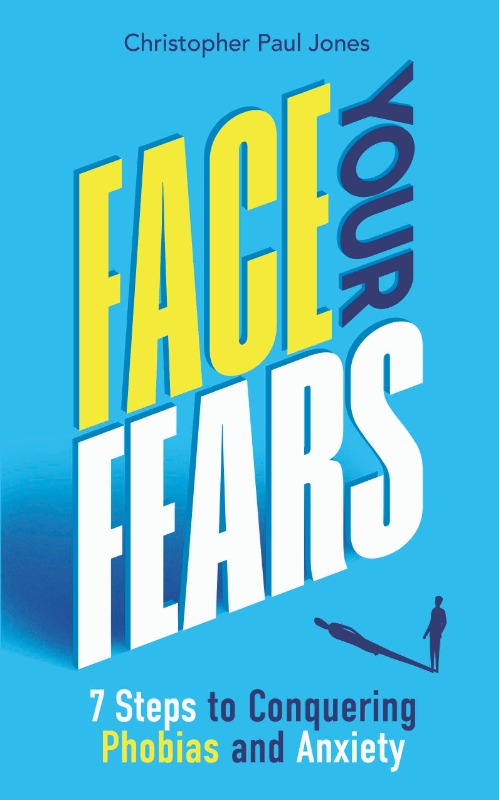search
date/time
 | Cumbria Times A Voice of the Free Press |
1:00 AM 27th April 2024
lifestyle
Phobias: Causes And Solutions
By Christopher Paul Jones, author of ‘Face your Fears’

Photo by Nick Fewings on Unsplash
What triggers a phobia?
There are many reasons behind the development of a phobia. With snakes, evolution has likely hardwired us to avoid them. Spiders tend to stimulate feelings of disgust and repulsion which trigger a fear response. Witnessing others' fear of cats can lead us to develop a phobia ourselves. For some people, especially children, somebody wearing a mask where they have a fixed unchanging expression can lead to a fear they can’t control.
So, How Can We Change This Fear?
Most phobias can be addressed, and in the majority of case they can be removed completely. There are seven stages to this process, which I call the Integrated Change System. The seven steps are known as the seven Rs.
1.Recognize what you’re really afraid of
Understanding the roots of any phobia is crucial. Identifying not just the surface-level fear but also the deeper fears it represents is key. Instead of asking, "Why am I afraid of wasps?" focus on questions that go deeper, like "What specifically about wasps scares me?" "When did I first feel this fear?" and "What do I need to believe to feel this way?"
2.Relax the conscious mind
Calmness is the key to accessing emotions and letting them go. Achieving a state of relaxation allows us to work with these fears more effectively.
The process is the "4-7-8 Breathing Technique," which involves inhaling quietly through the nose for four seconds, holding the breath for seven seconds, and exhaling forcefully through the mouth, pursed around the tongue, for eight seconds. This breathing pattern, repeated three to four times, acts as a natural tranquilizer for the nervous system. It's particularly effective in reducing anxiety because it increases the amount of oxygen in the bloodstream, slows the heart rate, and stabilizes blood pressure—counteracting the physiological symptoms of anxiety.
3.Reward for your fear (Secondary Gain)
Phobias can serve hidden purposes even if it doesn’t seem logical. Emotions aren’t logical. Things like avoiding situations we find uncomfortable, receiving attention and care from others, or feeling that fear protects us or keeps us safe are all hidden gains. Identifying the secondary gains can help us change any blocks that stop us from letting go of our fear. One way to find the secondary gain is to ask, "Does this fear keep me safe from situations I perceive as dangerous?", "Do I receive comfort or attention because of this fear?" “What might I lose if this fear were to disappear now?” Trust your first answers that comes; you might find some things you had never thought about before.
4.Recipe (Deconstructing your Strategy)
Everything we do, including phobias, operates according to a subconscious 'recipe'—a sequence of thoughts, behaviours, and feelings that reinforce, in this case, the fear. By getting clear on our recipe for fear, it becomes easier to change it. A highly effective technique involves changing the internal representation of the fear.
Visual Changes: Imagine the thing that triggers your phobia. Now, in your mind’s eye, start to shrink that image, make it lose its colour until it’s black and white, and then let it play backward like a film reel running in reverse. This process helps in diminishing the emotional impact the image has on you. The absurdity of a swan walking backward in a silent movie fashion creates a distance between you and the fear.
Auditory Changes: Pair this altered visual with a change in any sounds associated with your fear. If the bark of a dog is a trigger, imagine that sound becoming high-pitched, like a cartoon character, or even overlay it with a ridiculous sound effect. Incorporating humorous or nonsensical auditory elements further breaks down the fear's intensity. This is similar to the Ridiculous Spell in Harry Potter; by actively changing how we visualize and hear our fears, we engage different neural pathways, reducing the original stimulus's emotional and physiological impact. Moreover, laughter and humour have been shown to reduce stress hormones such as cortisol and adrenaline.

This step addresses the root of the fear, often buried in past experiences, by finding the first event and changing the mind's link to fear. This can then have an effect on how somebody will feel about that fear in the future.
One way to release the past is through tapping. Begin by clearly identifying the fear or specific event related to your phobia. This might be a past incident where you felt threatened or scared. Hold this memory in your mind.
The Setup: Start by tapping on the karate chop point (the outer edge of your hand) with the fingertips of the other hand. As you tap, verbalize your fear and your acceptance of yourself despite this fear. For example, "Even though I have this fear, I deeply and completely accept myself."
Tapping Sequence: Proceed to tap lightly but firmly on the sequence of points: the eyebrow, side of the eye, under the eye, under the nose, the chin, the collarbone, under the arm, and top of the head. While tapping each point about seven times, briefly state your fear to maintain focus on the issue.
Reframing: After a few rounds of tapping, begin to introduce a positive reframing of your fear. For instance, "I choose to release this fear" or "I am open to feeling safe around water." Tapping on specific meridian points while focusing on a fear or negative emotion sends signals to the amygdala (the brain's fear centre) to calm down, reducing the emotional intensity of the memory.
6.Recondition your emotions
The essence of emotional reconditioning lies in recognising that our responses to any fear-inducing stimuli are learned behaviours, much like Pavlov's dogs learned to associate a bell with food. The good news? Just as a response can be learned, it can also be unlearned or modified.
One way to do this is an exercise known as Emotional Anchoring. This technique is all about replacing the fear response with something more positive, switching our automatic fear of dogs to a calmer or even positive reaction. Here’s how:
Choose a Positive Emotion: First up, decide on the positive feeling you'd want instead of fear. This could be calm, happiness, or courage. Think of this emotion as your new reaction when you think about or see the feared thing – let’s say spiders in this example.
Find a Memory: Select a memory where you felt this positive emotion strongly. It could be any happy or calm moment from your life. The key here is that the feeling should be powerful and clear.
Create Your Anchor: While immersed in this memory, do a simple physical gesture, like pressing your thumb and forefinger together. This gesture is your anchor. It’s a physical action tied to your positive emotion. Now find a new memory and do the same again keep doing this till the act of squeezing your fingers takes you straight to a positive feeling.
Now start thinking about spiders or looking at pictures of spiders, using your anchor. Notice how you feel. What we're doing here is creating a new pathway in the brain. Every time you use your anchor and feel that positive emotion, you weaken the old fear response and strengthen the new, positive one. It’s a bit like carving a new path in a forest. The more you walk it, the more defined it becomes.
7.Realise a powerful future:
Step Seven is about crafting a future where fear doesn't dictate our choices, transforming "what-ifs" and "yes, buts" (which are often the mantra of the anxiety mind) into new positive possibilities.
This is called the "Yep But" and "What If" Exercise:
Start by jotting down the most frequent "Yep but" and "What if" thoughts that bubble up when you think about your phobia. This might be something like, "Yep, but last time didn’t go well," or "What if the cat jumps onto my lap?"
Now challenge them: For each "Yep but" and "What if," ask yourself, "Is this thought helping me or hindering me?" Challenge the validity of these thoughts. How many of these imagined scenarios have actually happened? How many are based on assumptions rather than facts?
Script Flipping: Now, for the fun part—flipping the script. Rewrite each "Yep but" and "What if" into a positive statement or question. For example, "Yep, but last time didn’t go well," becomes "What if this time, I feel more prepared and confident?" Transform " What if the cat jumps onto my lap" into "What if the cat calmly sits on the floor close by?"
Visualization and Affirmation: Take your statements and visualize them. Close your eyes and picture the positive outcomes. Pair this with affirmations that reinforce your new narrative, like "I am capable of feeling calm and in control around cats."
After following these steps and repeating them as needed, you may find that your fear becomes reduced. You can find more detailed processes for dealing with dog and other phobias in my new book, "Face Your Fears."
.jpg)
Christopher Paul Jones
Business Book Review: Face Your Fears